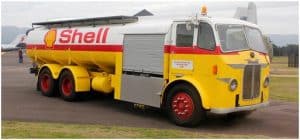Leyland “Hippo” Tanker

History of the HARS Tanker
The HARS tanker is a 1952 Leyland ‘Hippo’ imported new to work as a refueller by Shell at Sydney’s (then called) Mascot Airport.
The original fleet number would have been ERMC 303 which had significance for identifying the vehicle.
E = Jet Fuel
R = Rellumit microfilter
M = Motorised
C = Tanker with a capacity of ~3000 gallons (~ 13,600 litres)
3 = Pump rate which indicated Gallons per minute x 100 (Actual pump rate was ~220gpm or ~ 900 litres /minute.
History of Type
The Leyland “Hippo” tanker was capable of refuelling, defuelling, self loading and circulating within the system through a valve selector called a “diverti” valve. It was easy to move the diverti valve to circulate, which showed flow on the meter but did not actually transfer fuel. Most of the old refuelling tankers had this system. There were Mark 1, 2, 3 and 4 production versions.
The tanks in the tanker had 2 to 5 compartments, each one filled through a bottom fill and selected by a valve from the fill manifold. It was common practice to open all valves and have someone on top of the vehicle to dip the tank and monitor the fill. There was no auto shut-off. The back compartments filled first and it was necessary to get the caps on the dip tubes to stop fuel spray in the final stage of fill. Sometimes the valves did not get closed quickly enough and the man on the top got a bit of a jet fuel shower.
Like many WWII production vehicles, there were no driving refinements. The Hippo was heavy on steering and the manual clutch and gearbox required skill and strength to operate. For example, the Power Take Off (PTO) selector lever could slip out of position while travelling and would isolate the gear box requiring you to stop the vehicle and pull the lever back to storage position so you could get moving again.
Technical Specifications
Engines: Leyland 600 diesel engine producing ~125 BHP at ~1800 rpm, it displaces ~9.8 litres and the six pistons run through a bore of ~4.8 inches over a stroke of ~5.5 inches.
Brakes: Vacuum-assisted.
